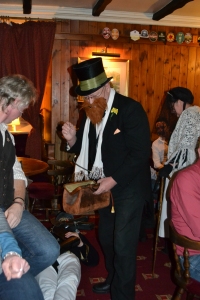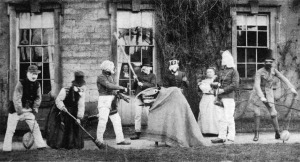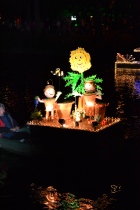“December 26th. — This evening we had several sets of children ‘guising,’ dressed up in all sorts of queer ways, and singing one thing or other. The ‘Hobby Horse’ came too. Five men — one as a devil, one as a woman, one as an old woman with a besom, one with the Hobby Horse, and one as something or other else. We had them in the kitchen and gave them money.
December 27th. — Troops of children ‘guising’ again. We gave something to each lot. In the evening the Winster ‘Snap Dragon’ and ‘Hobby Horse’ conjoined came to us — ten men, one as Snap Dragon, two with Hobby Horses, two devils, etc., etc. We had them in the kitchen and gave them money.
Llewellynn Jewitt diary from 1867
Anyone who has been following this blog or occasionally visits will know I do enjoy a Mummer’s Play or Folk Play…I could fill the blog with accounts and some years I might experience 20-30 or so from across the country and over the seasons. Previous posts being testament such as the Soulcakers, Nottinghamshire Plough Monday plays and Ripley Guisers..but there are many more of course. One such tradition, a stable mate geographically with Ripley is that of the Winster Guisers, is worth exploring. Why? This is because the group, although a 1980 revival, is based on a curious photo from around 1870 and are rather bizarrely and frighteningly attired.


Keeping mum on the origin
Some authorities have argued that as Winster has a Morris tradition that the photo is of a Morris troup. Let us look at the evidence on both sides. Firstly, the season, the lack of leaves on the vine in the background suggests winter – the season of mainly mumming not Morris. However, two characters have musical instruments suggesting that the group are dancing yet music does appear in such folk plays for example the Poor Old Horse. This is particularly significant drawing reference to this as the tradition was a Derbyshire-Nottinghamshire-Yorkshire one and the photo may capture a rendition. However, the evidence against this are the other characters – particularly those on what appear to be hobby horses, something more apparent in Morris. However, surely these characters are soldiers riding their horses. Some authorities such as ….state that they do not appear to be in combat, but surely it is not difficult to consider they might jousting with their horses being the objects of conflict? The brooms held by the other characters are more difficult. Broom dancing does exist in Morris but it appears restricted to Molly dancing an eastern tradition of East Anglia and Lincolnshire. Alternatively and more likely these are the sweepers off commonly seen in renditions of the Derby Tup, again a locally prevalent folk play. The final evidence in favour are again those costumes – there is no uniformity, a facet commonly seen in Morris and they are disguised. The wearing of masks of course is unknown in Morris who would use other forms such as blackening to disguise their features. This does not exclude the possibility but surely the wearing of masks would be an encumbrance for a dancer? It appears all pretty conclusive I feel, and perhaps doubts have only crept in as a result of Winster’s rather odd Morris hangers on – a witch, clown and sergeant – but could these have come from the mummers and not evidence of the other arrangement? Whatever the truth this evocative photo was used as the basis for the modern team but of course a photo does not provide a script. I enquired about this and the team asked older members of the community who suggested the characters and snippets of the play.

The team have very faithfully resurrected the costumes from the photograph – the two protagonists wearing military jackets with white trousers. Their heads being wrapped in a white cloth with a clown like imaginary painted upon it. The other characters have been resurrected – the besom carrying one and the doctor. The script coming from a Cheshire souling play the most likely candidate but no one other than an expert of folk plays would notice of course.
Truly Dis-Guised
I turned up late for the first performance at Matlock..their schedule said 8.45, they started at 8.15…early for mummers is virtually unheard of it was probably a typo. At least this gave me time to settle in at their next venue and get a prime location.

Soon the play started to a very receptive audience, many of whom had turned up to see it (it is good to advertise). In came the Introducer:
“I open the door and I enter in
Your favour I shall win
Here I stand, sit or fall
I’ll do my best to please you all.
A room to enter in
Come raise up the fire, for in this room tonight, there’s going to be a dreadful fight,
So much a fight in this house, we’ll make the rafters ring
If you don’t please the words I say..step in St George, clear the way…”
Then in came the main protagonists Saint George followed by the Black Prince of Paradise both riding curious hobby horses. In came a rather rapid St George on his unusual hobby horse:
“I am St George, noble champion bold,
And was with this sword I will fight crimes again
It was I who fought that fiery dragon and brought him slaughter
For my valour I won fair sheila the King of Egypt’s daughter.
I’ve travelled the world, round and round, is not a man to equal me never have I found,
Shall meet the man that dare stand in front of me and I’ll cut him down with sword in hand
Black Prince: I am Black Prince of Paradise, born of high renowned,
And with this sword I soon fix thy loafty courage down,
In Black Morocco I am King and before this night old,
I’ll see thee lie dead upon this floor and make thy blood run cold
St George: What that thy sayeth
What I say I mean
Stand back thy black Morrocan dog or I’ll drive sword thy die
Cut thy body in four parts and make your button’s fly
I cast thy cut my body in four parts and make your button fly,
My head is made of brass, Me body is made of steel
My arms and legs are knuckle bone and challenge the to feel
Black Prince: Pull out thy purse and beg
St George: Pull out thy sword and fight!
The satisfaction I shall have before I thou goes away tonight.”
Horsing about?
What is unusual about the team shown in the photo are the small hobby horses which these protagonists ride between their legs geld by a cord around the rider’s neck. These appear to be like wooden rocking horse having a flat curved neck with small head and snapping jaws are about two feet long with a cylindrical body. The question being are these the snap dragons or the hobby horses described by Llewellynn Jewitt? Folklorist Cecil Sharp noted that a real horses head snap dragon was being used in 1908 however confusingly the Winster Morris in 1966 state they never had a hobby horse but did have a ceremony where a horse skull would be buried each year and dug up. That is a tradition which survives at Antrobus soul caking – more of about this skull later.
Dying for a pint
King of Egypt enters similarly disguised in cloth with an Arabic hat: “I am the King of Egypt as proud doth I appear, I’ve come to seek the young black prince who is my son and heir.Where the man who doeth sway is and precious blood he spill?Who is the man upon this ground my only son did kill?”
St George: I did him slay was I who did him kill and on this ground his precious blood did spill. He challenged me to fight with him, did he, before I be a coward, I fight until I die
King of Egypt: St George, St George what have you done, you’ve gone and killed me only son.
My only son, my only heir, how can you leave him bleeding there?
This part then leads to the traditional entrance of a female character, usually a man in drag, but unusually and especially for this year…an actual women:

“Looks like there’s been some fighting in ‘ere , looks like we need a doctor
Is there a doctor who can cure this man of his deadly wounds?
King of Egypt: I’ll give you five pounds for a doctor
Doctor: There’s no five pound doctor.
King of Egypt: I’ll give you 10 pounds for a doctor
Doctor: In comes I who’s never late, With my big head and little wit, my big heads so big and my wits so small, I’ll endeavour to please you all, man of noble vein, no more than thee or any other man
I cames the to be a doctor?
Doctor: By my travels
Why how far hast you travelled?
Doctor: I’ve travelled up and down the country in this manner or that, I’ve travelled from the fireside to the bedside, from the bedside to me grandmother’s cupboard side, got many a lump of mouldy cheesey pie crust that has made me such a fine upstanding figure of man as I am.
Is that all?”
No I’ve been to Italy, Spitaly, France, Germany and Spain and I come back to the insert pub name again,
What have you seen on your travels?
Two dead men fighting, two blind me seen fair play, two men acting arms pick them up and carrying them away and two dumb men shouted horray horray.
What canst you cure?
I can cure The ip, the pip, the stitch, the patsy and the gout, the pains within and pains out
There be nineteen Devils in a man’s skull I cast 21 of them out.
What else canst you cure?
I can cure a horse of the gout
How does you do that then?
Cut it off and kick it about!
Can you cure hotels?
I can cure horse of the piles
How does you do that?
Flick some salt on its arse and ride it for miles
Is that all your can cure?
No in this bag I’ve got all manner of things, crutches for lame ducks, and spectacles for blind bumblebees, splints for grasshoppers with broken legs and many other useful things
Any chance of curing this man then doctor?
I, I got some medicine. three sips from this bottle, go down his thittle-throttle, If not entirely slain, rise up and fight again.”

What is clear perhaps from these doctor incidences is that in such communities the doctor was always a questionable character or that one of the least worthy men in the troup played him! After resurrecting the Black Prince he decides to fight St George again but is stopped and the starts the long sequence of begging. One of the most amusing being Little Johnny Jack, played by one of the tallest of the group, who delivered his lines with great emphasis and who had a collection of dolls stuck to his back:
“In comes I little Johnny Jack, it’s my wife and my family I got on my back, now my family is large and I’ve had a little fall, so a little please will help us all. Out of twelve children I’ve got but five, all the rest they’re starving alive, some in workhouse and some down mine, I’ll bring them all with me when I come here next year. Now Christmas comes but once a year, but when it comes it brings good cheer. There’s turkey and taters, and mince pies and no one likes this sort of thing more than these guisers and in. So ladies and gentlemen, sit there at your ease, but you’ll have to give a little to these guisers if you please. And if you don’t give enough to these lads and so then I’ll go back to the beginning and do it all over again.”

The last line getting the best roar of the whole performance. Johnny Jack was joined by Beelzebub a traditional more threatening character and Little Devil Doubt who threatened:
“In comes in Little Devily doubt and If you don’t give me your money I’ll sweep you all out. It’s your money I want, it’s your money I crave and if you don’t give me your money I’ll sweep you to your grave. If you don’t believe the words I say..step in Old Horse and clear the way.”
This horse was the icing on this rather gruesome cake. A real horses skull, painted black with red circle eyes and controlling it unseen beneath a black sheet it’s handler…it moved on all fours with an eerie quick slow fashion like a horse out of control, or rather like a more benevolent Emu of Rod Hull fame!. He’s rider again eliciting sympathy:
“In comes our old horse to bring you good cheer, Merry Christmas and Happy New year..he was a fine horse and now he’s dead, all is left is this poor old horses head, Cause he’s old with wrapped a blanket around him to keep him from the cold. Now he’s come to your house to see you, I pray I look around, a fine horse as ever there’s been
He’s got a Head as handsome as any Derby winner, But nose fine and noble, like a piece of Worcester China, Got an Eye like a hawk and a neck like a swan, ears less as keen they can hear the bells in Pomy church even when not ringing, he’s got a row of teeth big and bright, like new tombstones…a champion horse very well bred..travelled far, he’s been to Buxton and once as far as Elton.
King and Queen once rode behind him and bought him a neat coat but no only pulls an old milk float…When he was born his mother fell dead on spoonfuls of honey he was nursed and fed. Once he danced to many a tune, now he only has one leg and with this leg he has to beg..some coppers and some beer…he’ll dance you a gallop if you come next year.”


The team sung us a Merry Christmas and the very appreciative audience, one of the best for a mummer’s play, dug deep for charity! Reflecting on a very amusing performance, one could understand the popularity of such plays then when there was an element of surprise in both the characterisation and dress perhaps in the days when many did not see regular performance. The fights which must have been common place in pubs – they still are – easily got the attention. That combined with patriotic tendencies underlining it was a good one to elicit sympathy and support in the days when everyone appeared to be an enemy the other side of the channel! Furthermore, the plays gave the working classes the opportunity to ridicule the figures of authority as well…the language in some cases may seem a little odd and obscure, but the plays still have the power to make audiences laugh and of course dig deep. Winster Guisers, with its bizarre and scary costumes, unique hobby horse and eerie horse is something the town of Winster should be very proud of. Catch it if you can.
Spot the difference!






















